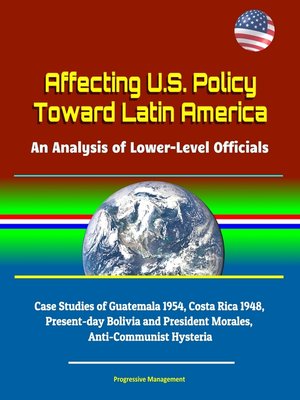Affecting U.S. Policy Toward Latin America
ebook ∣ An Analysis of Lower-Level Officials--Case Studies of Guatemala 1954, Costa Rica 1948, Present-day Bolivia and President Morales, Anti-Communist Hysteria

Sign up to save your library
With an OverDrive account, you can save your favorite libraries for at-a-glance information about availability. Find out more about OverDrive accounts.
Find this title in Libby, the library reading app by OverDrive.



Search for a digital library with this title
Title found at these libraries:
| Library Name | Distance |
|---|---|
| Loading... |
This excellent 2018 report has been professionally converted for accurate flowing-text e-book format reproduction.
In this paper, I examined U.S. foreign policy toward Latin America, primarily during the Cold War. I sought to answer the following questions: (1) What factors influenced the behavior of lower-level U.S. officials stationed in Latin America at the time? and (2) How much policy-affecting agency did these officials have? Using primary source documentation contained in the State Department's Foreign Relations of the United States (FRUS) volumes to the maximum extent possible, I examined the following case studies: Guatemala circa 1954, Costa Rica circa 1948, and lastly, present-day Bolivia. In my research and analysis, I shed light on the dynamic that existed between Washington policymakers and lower-level officials stationed in-region, mainly ambassadors. My analysis resulted in the following conclusions: (1) anti-communist Cold War hysteria clouded the judgment of lower-level officials, (2) pressure from Washington elites largely influenced the behavior of these officials, and (3) U.S. officials stationed in-region had relatively little policy-affecting agency. Ultimately, I make a case for a U.S. foreign policy apparatus that empowers lower-level officials stationed in-region. This arrangement will prove most effective in observing, analyzing, and appreciating the nuances present in foreign countries, which would result in a flexible and tailored U.S. foreign policy.
I. INTRODUCTION * A. MAJOR RESEARCH QUESTION * B. SIGNIFICANCE OF THE RESEARCH QUESTION * C. LITERATURE REVIEW * 1. Exaggerated Fear of Communism in Latin America * 2. U.S. Paternalistic Image of Latin America * 3. Lack of Latin Americanists * D. POTENTIAL EXPLANATIONS AND HYPOTHESES * E. RESEARCH DESIGN * F. THESIS OVERVIEW AND DRAFT CHAPTER OUTLINE * II. REFORM AND REACTION IN GUATEMALA * A. INTRODUCTION TO GUATEMALAN CASE STUDY * B. WHERE THE CURRENT DEBATE STANDS * C. AMBASSADOR KYLE'S RESPONSE TO A REVOLUTION, 1945-48 * D. PASSING AMBASSADOR PATTERSON'S "DUCK TEST," 1948-51. * E. THE "RED MENACE" CONTINUES TO RISE: AMBASSADOR SCHOENFELD, 1951-53 * F. MAN ON AN ANTI-COMMUNIST MISSION: AMBASSADOR PEURIFOY, 1953-54 * G. CONCLUSIONS REGARDING GUATEMALAN CASE STUDY * III. COSTA RICA AND PRESIDENT FIGUERES * A. INTRODUCTION TO COSTA RICAN CASE STUDY * B. PRESIDENT RAFAEL CALDERON GUARDIA, 1940-44 * C. PRESIDENT TEODORO PICADO MICHALSKI, 1944-48 * D. PRESIDENT JOSE FIGUERES FERRER: 1948-49 AND 1953-58 * E. CONSISTENCY IN U.S. POLICY DESPITE DIFFERENT OUTCOMES * F. ANALYSIS OF AGENCY OF LOWER-LEVEL U.S. OFFICIALS * IV. A CONTEMPORARY CASE STUDY: EVO MORALES IN BOLIVIA * A. INTRODUCTION TO BOLIVIAN CASE STUDY * B. A CONTROVERSIAL FIGURE RISES IN BOLIVIA * C. U.S. OFFICIALS' REACTIONS TO MORALES * D. MORALES' S MOTIVES AND AN ANALYSIS OF THE FACTS * E. FINAL THOUGHTS ON MORALES-BOLIVIA CASE STUDY * V. CONCLUSION AND FINAL THOUGHTS * A. REVIEW OF PREVIOUS CHAPTERS * B. LIMITATIONS OF THIS PROJECT * C. THEN AND NOW IN U.S. FOREIGN POLICY * D. CONGRESSIONAL FINDINGS ON THE ISSUE OF U.S. FOREIGN POLICY







